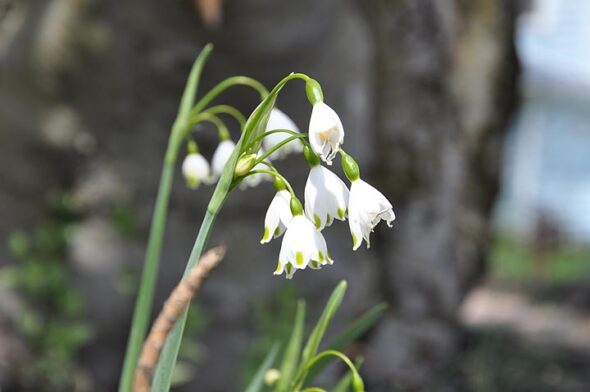
Spring snowflake. (Photo by Audrey Hackett)
50 years on: Earth Day in Yellow Springs
- Published: April 22, 2020
It was the first Earth Day, April 1970, and the environmentally conscious village of Yellow Springs commemorated it in local fashion — that is, a combination of serious intellectual study, theatrical display and quirky fun.
“Antioch College students, joining with townspeople in an ambitious Earth Week program of talks, workshops and discussions, climaxed their efforts to dramatize the dangers of pollution with a lively parade and well attended Earth Fair Saturday at Mills Lawn,” the Yellow Springs News reported at the event’s end.
Ambitious it was. The “Non-Polluting Parade” featured two- or three-hundred “mostly young people” walking, jumping, riding bikes and horses, and pulling vehicles. The Earth Fair had pony rides, a children’s zoo and art show, educational exhibits and an auction of reusable items.
Speakers over the week included prominent environmentalists David Brower, the first director of the Sierra Club; Sheldon Novick, associate editor of Environment Magazine; and the ecological poet Gary Synder.
Invitations were handed out the weekend before with fresh loaves of bread made from organic ingredients and baked at the Antioch Inn. And in one dramatic display, Yellow Springs High School students piled a week’s worth of trash they picked up from around downtown at Reed’s Service Station.
Fifty years later, another ambitious commemoration, largely planned by the Glen Helen Ecology Institute, had to be canceled due to a stay-at-home order to contain a global pandemic. The Glen itself had to be closed for safety reasons.
So the News has invited some of our own prominent local environmentalists to reflect on the occasion. They were invited to write about where they saw environmental progress over the last 50 years, what issues need more urgent attention and what they envisioned for our future, both locally and globally.
As we spend this Earth Day — and Earth Week — in our own backyards, rather than together fighting for change, we might be reminded that much change, ultimately, begins with ourselves.
—————————————-
Stay vigilant after Earth Day
by Nick Boutis*
Let me begin with a bit of blasphemy, by way of admitting that I’m actually not a fan of Earth Day. Sure, we try to make the most of it in Glen Helen, and were it not for coronavirus restrictions, we’d be looking forward to a host of public programs in commemoration of the day. But, I’ve long held the opinion that holiday perpetuates the idea that caring for the Earth is something that happens on the margins of how we live our lives, rather than at the heart of it.
It wasn’t always this way. In the Glen Helen offices, we have a book from the group Environmental Action, published in 1970 shortly after they coordinated the activities on the first Earth Day. Their words show remarkable perspective: “April 22, 1970 — Earth Day. Nearly 20 million people participated… a generation dedicated itself to reclaiming the planet. A new kind of movement was born… If the environmental movement succeeds it will profoundly change corporations,
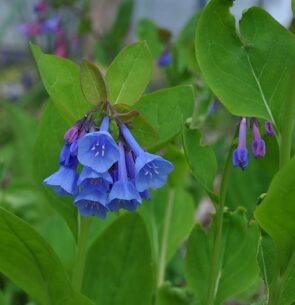
Virginia bluebell, a native woodland species. (Photo by Audrey Hackett)
government and the way each of us lives.”
Drink that in: the people who founded Earth Day did so with the hope that it would be the start of a movement, not the start of a new holiday.
The first Earth Day really did represent the coming out party for a movement, a movement that made breathtaking gains in the early 1970s. In rapid succession, and all while the Vietnam War raged, the Environmental Protection Agency was created, and Congress passed, and President Nixon signed, the Clean Air Act, the Clean Water Act, and the Endangered Species Act. Since then, progress has slowed, even as awareness of Earth Day has grown.
And, as we all know, big challenges remain. They are numerous, and it would be disheartening to list them all, but I worry most about climate change, loss of biodiversity, and humanity’s continued feeding frenzy on nonrenewable resources.
These are all big and global issues, that can only be solved by nations working collectively — the cumulative impact of individual actions on a global level. We lament climate change, yet with every gallon of gas we use, we put nearly 20 pounds of carbon dioxide into the air. If I were the only person that lived in the state of Ohio, it wouldn’t make a whit of difference if I drove to work every day. The Earth can absorb one person worth of greenhouse gases without consequence. But there are about 330 million people in the United States, and 7 1/2 billion in the world. Cumulatively, we are changing our air, which is changing our climate, which, ultimately, will destabilize our planet.
But this depressing information is precisely why I think Yellow Springs is such a wonderful and important place to live. Here, and evidenced by public support for Glen Helen and other environmental initiatives, we already have a broad recognition that it is vital to make choices with the needs of the Earth in mind. In essence, I believe that we are already a community that has moved beyond thinking of Earth Day as one day in 365 – that we treat every day like it is Earth Day.
Living up to this idea requires constant vigilance. Within Glen Helen, once we are able to reopen and again welcome 100,000-plus visitors a year, we also must take care of the preserve and all of the plants and animals that depend on it. Every day we work to strengthen the ecological health of the Glen. Doesn’t that mean that every day is Earth Day?
I see the same thing play out in my neighborhood on the north side of town. In April and May, I like to walk with a set of binoculars, looking for migratory birds like warblers and vireos. With these long-distance travelers, I feel like we’ve made a pact that has lasted for millennia, and says something like… “We hope you enjoyed your winter in Costa Rica. Welcome back. We’ve taken care of your summer home for you.” Stewarding habitat for wildlife requires ongoing effort, but as my neighbors and I clear honeysuckle and foster native plants, we do our part to shelter biodiversity. Not one day a year, but consistently.
This is also the essential message that we work to impart to the children at the Outdoor Education Center. For over 60 years, the OEC has been shaping the way children think about the environment and their place within it. Without hyperbole, it can be a transformative, life-changing experience. Kids come to understand that we are part our environment, and that our environment can support and nurture us if we do the same for it. Yes: every day.
*The writer is the executive director of Glen Helen.
———————-——————
Youth are the tipping point
by Ed Davis*
“The truth about the nature of risk of thermonuclear war is available. The reason why it is not embraced is that it is not acceptable. People cannot risk being overwhelmed by the anxiety which might accompany a full cognitive and affective grasp of the present world situation and its implications for the future.” —LeGuinsporre, Peace News, Nov. 6, 1964
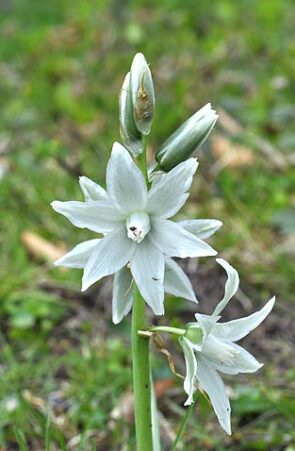
Star of Bethlehem. (Photo by Audrey Hackett)
Substitute “climate collapse” for “thermonuclear war” and the above quote perfectly describes the current situation as we face Earth Day 2020. On one hand, it seems as if there’s little hope of governments, especially our own, attacking this problem with the united vigor currently being expended on the coronavirus pandemic. However, I’m more hopeful than I’ve been since Al Gore’s “Inconvenient Truth” (2006), because young people are joining, even leading the climate movement, internationally as well as locally, to face the greatest crisis of our lifetime.
I’ll remember 2019 as the year teenagers made governments listen; whether politicians will act with the required urgency remains to be seen. I’d never heard of Greta Thunberg until last summer, but it didn’t take me long to recognize her as the perfect storm the environmental movement needs. Behind the Swedish teenager stand legions of believers with her same uncompromising glare and articulate voice. She represents the most hopeful sign I’ve seen since Gore’s documentary — and seeds of hope are being planted right here in Yellow Springs.
Our village excels in providing nature literacy for the young that is up close and personal. Many of Glen Helen’s programs prepare kids to get that “full cognitive and affective grasp of the present world situation” that will empower them to take the action required when they’re older. However, there’s nothing like the Glen’s EcoCamp to help kids care enough about Mother Earth to demand she get at least as much money spent to save her as we’ve spent during the current pandemic. Without such life-changing experiences as staying out all night to see, smell and absorb Earth’s nocturnal mystery, how does a person become passionate enough to make the necessary sacrifices to reach the most ambitious of goals?
Then there’s Operation Bluebird, the partnership between Tecumseh Land Trust and Yellow Springs schools, which lovingly transforms middle school students into citizen scientists. The “classroom” for the past three years has been Kate Anderson’s Xarifa Farm, and would’ve included Agraria this year, if the pandemic hadn’t canceled the event. Kids as well as adult volunteers have a blast feeling the sun on their shoulders while counting eggs in the boxes and recording data, with bluebird parents hovering nearby. The kids learn to see. Seeing is caring. Caring becomes acting.
Speaking of Agraria, Community Solutions’ wonderful addition to ecological education will lead to nature experiences we’ve hardly fathomed yet. According to their website, “The Nature School mission is to connect children and families to nature, themselves, and each other. We protect and steward what we love; our programs help foster compassion, curiosity, and trust with the natural world by giving participants space and time to fall in love with the outdoors … so that they grow into dedicated leaders and environmental stewards in their communities.” Again: up close and personal.
For good or ill, our “community” must now be the world and Earth Day must be every day. However, I hope not to imply the burden rests solely — or even mostly — with the young. The movement they’ve so galvanized will only succeed with the help of every one of us. We can and should recycle, drive and fly less, and use less plastic, but as crucial as these personal efforts are, change will require unprecedented governmental intervention from industrialized countries, especially the U.S. We’ve got to convince Congress that climate collapse deserves even more effort than we’ve put so far into the pandemic. Yet I believe that the addition of our young people’s passion, energy and uncompromising toughness may well be the tipping point we need if our planet is to remain our wild, beautiful, welcoming home.
* The writer is a local poet, novelist and workshop leader.
———————-——————
Make Earth Day every day
by Catherine Zimmerman*
As a high school sophomore in 1970, I witnessed the first Earth Day and the birth of the Environmental Movement. This revolution was spurred in large part by Rachel Carson’s book “Silent Spring,” which raised national and global awareness about air and water pollution and the effects of that pollution on the health of species, including the human species. This made a huge impact on me.
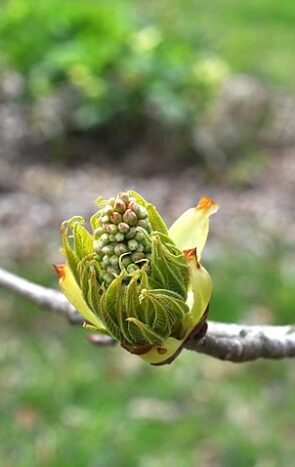
Buckeye flower.
(Photo by Audrey Hackett)
In the late ’60s, environmental activists worked across the country to harness the energy of college students, already engaged in anti-war protests, and groups fighting to clean up the environment. The result was that environmental concerns rocketed to legislative level action. The Environmental Protection Agency was created in 1970 to address and regulate polluters and outlaw pollutants like DDT. Much important work has been done in the ensuing 50 years. However, in the last three years we can see how fragile the EPA is with the rollback of national environmental regulations. This makes state and local level environmental efforts critical to maintaining healthy ecosystems and communities.
As a filmmaker and environmental activist, I have traveled the country documenting initiatives focused on repairing and supporting broken ecosystems. While much of what I have seen is at the grassroots level, more and more government agencies are getting onboard, often spurred by citizens. Citizens of Yellow Springs, your voice matters. After over 40 years living outside Ohio, that is one of the things I have found refreshing about returning in 2017 to live in Yellow Springs. People here are involved in their community.
There are a number of things we can do to carry forward Earth Day ideals:
• Let’s make it Earth Day every day. Focus on being in nature and supporting nature by being conscious that we are just one piece of the ecosystem we live in. Let’s do no harm.
• Make your concerns about environmental issues known to, I won’t list all the folks, let’s just say, everyone.
• Work to be educated about the environment and educate others, especially your students and children. Children are our all-important, future, earth stewards.
• Recycle.
• Stop chemically managing landscapes. Don’t bombard the earth with unnecessary fertilizers and pesticides, which include harmful herbicides utilizing glyphosate.
• Remove invasive species.
• Share your patch of earth with wildlife, birds, bees, butterflies and pollinators. You can do this by planting native plants. Native plants belong here and don’t require artificial inputs. Be sure to plant them in the conditions the plant requires. In turn, Mother Nature will do her thing — she knows best — and you will be part of bringing the ecosystem back in balance.
One important way to advocate for the environment is to get involved in government. That’s where the laws/rules we live by everyday get decided.
Following my own advice, I am now a member of the Environmental Commission. One of the 2020 goals of the commission is to make Yellow Springs more environmentally in sync with nature. After the stay-at-home order is lifted, we will launch a National Wildlife Federation initiative to certify Yellow Springs as a Wildlife Habitat community.
On the 100th Earth Day celebration, in the year 2070, I’ll be rocking with the nematodes and other soil critters, making everything a little more in balance. Meanwhile, above ground, I expect a more enlightened crowd, especially in Yellow Springs. People will drive less and walk more. There will be a return to growing our own food and pollinators will be in abundance to pollinate those food crops. Natural landscaping will be the new norm and riding mowers will have long since rusted away, a footnote in the history of lawn. Yellow Springs will be a decades-old leader and community model in protecting the environment and preserving natural spaces, because the citizens back in 2020 had the clarity to change course and go all out to protect Mother Earth.
*The writer is a local filmmaker, environmentalist and horticulturist.
———————-——————
Never forget this Earth Day
by Krista Magaw*
It isn’t the Earth Day we anticipated — with our native plant swap, renewable power demonstrations, recycling awareness and plans for gardens and farms. But the jolt of the coronavirus, and our sudden organizing to get through it together, might give us something more — the realization that everything in nature is connected. Suddenly the motivation to grow food in our gardens, and on local farms, grows exponentially. The solace found in flowers, frog songs, returning birds and butterflies is much needed.
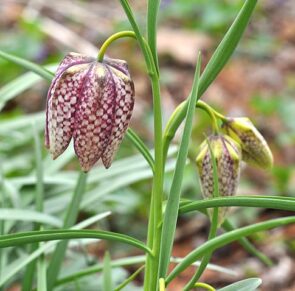
Snake’s head fritillary, also called “chess flower.” (Photos by Audrey Hackett)
The very first Earth Day celebrated was meant to give us just such a jolt. It did indeed change America in some big ways. That first Earth Day I was a freshman in high school, the Vietnam War was dragging on and the Cuyahoga River was on fire. Our student council leaders, radicals in the context of Galion, Ohio, created a sense that change was in the air. Their teach-in pointed the way to some needed changes in America, and, gradually, our air and water became cleaner. The toxic effects of landfills were mitigated across Ohio. And so many years after Teddy Roosevelt protected national wildlands at the rate of 80,000 acres a day, we started protecting more land for Americans and visitors from all over the world to enjoy.
My husband, daughter and I moved to Yellow Springs a little after the 25th Earth Day, and we discovered another small Ohio town, one that had learned much about the connectedness of water and land, forests and fields, and the need for people to be vigilant about taking care of the places we live, and the places we love. No place is perfect, but the vision of so many people here, over such a long time, was inspiring, and not just regarding care of the natural world. The Quakers, Antioch leaders and other activists sought to address injustice, relocating former slaves here through the “Conway Colony”; Wheeling Gaunt sought to care for the poor and widowed, providing them flour.
Then, the opportunity to work for Tecumseh Land Trust gave me a new view, connecting humankind to the bigger, and amazing, natural world. I learned how many species the white oak hosts, and how important wetlands are to Ohio. I got to meet more amazing leaders and doers — among them George Bieri and Brother Don Geiger — with visions to restore our miraculous natural systems.
I also learned about the limitations of our current systems to take care of our natural world. Our nation of farmers, having raised food for their families and the country for generations, either lost their livelihood or became a part of a bigger, more industrial agriculture. Even earnest hopes to feed the world did not always go well. Our water became plagued with blue-green algae, making it undrinkable, and harming plants and animals in ways we don’t yet understand.
The climate was changing, and many groups and individuals, especially in Yellow Springs, became aware and active. Tecumseh Land Trust had protected over 25,000 acres of prime farmland and natural areas, including more than 40 miles of stream, but we saw a path to further improve our soil and water. We could provide support for local farmers and landowners to explore new opportunities for conservation and for a more local food economy. We launched the Jacoby Partnership, bringing resources to preserve and improve land and water, and to pay for new and different best practices — cover crops, conversions to organic methods, and conscious use of pollinator friendly plants that bring productivity and diversity, as well as beauty.
But this Earth Day can push us further. As we cooperate each day to keep each other safe, we can also consciously work to assure food security for everyone around us in the future. We are really in this together, with all the miraculous life on the planet.
How do we start? One day at a time, day after day, we can become more aware of our connectedness, and more respectful of what that means. We need to vote, to volunteer, and to take care of ourselves, our families, our natural resources, our local food system, and our village in ways that respect each other and the earth.
*The writer is the executive director of Tecumseh Land Trust.
———————-——————
In Yellow Springs, a glimmer of hope
by Vickie Hennessy*
I am thinking of Earth Day in the midst of the COVID-19 pandemic.
Fifty years ago, on the first Earth Day, I was in my first year of college. Back then we worried about pollution: rivers were catching fire; acid rain was producing lakes devoid of life and eroding the features from outdoor statues; DDT was killing our birds by entering the food chain and thinning their egg shells; smog was everywhere.

Yellow trout-lily, a woodland species. (Photos by Audrey Hackett)
Eight months after the first Earth Day event, the EPA was initiated, and within the three years that immediately followed came the Clean Air Act, the Clean Water Act and the Endangered Species Act. With these stricter standards, things seemed to be looking up. Little did we know at that time the earth’s climate was gradually warming.
Now, climate change is our biggest environmental threat, and all the related and interconnected issues that ensue: habitat loss, polar ice melt, hurricanes, floods, drought, raging wildfires and endangered species. The best we can do to prevent these is to reduce greenhouse gases by reducing our consumption of fossil fuels. But the Trump administration so far has targeted about 85 environmental regulations that protect air, water and public health by prioritizing the elimination of regulations it sees as burdensome to the fossil fuel industry and the economy in general.
But let’s focus attention on our village of Yellow Springs, as here, I see a glimmer of hope for the environment.
First of all, 83% of the Village energy portfolio is purchased from renewable energy sources like hydroelectric, landfill gas, solar and wind. By contrast, renewables made up only 3% of Ohio’s total electricity generation last year, making us one of the “greenest” municipalities in the state. Additional efforts from the Village government and the Environmental Commission include updating the Wellhead Protection Plan; banning the use of toxic pesticides and herbicide on Village property; encouraging residents to cultivate natural landscapes in their yards; and working with the EPA and Vernay to protect villagers from potential contamination from a past chemical spill. Nonprofit organizations also contribute services to benefit the village environment. With these collective pursuits to sustain our environment occurring throughout our village, I can’t help but feel encouraged.
One issue that truly disturbs me is the overabundance of plastics. Because we have been sending our plastics to China for the past quarter century, the U.S. never developed the technology or the infrastructure to be able to recycle them here at home. Now there are no markets for them, and only about 10% of the plastic created is recycled. Short of bringing an entrepreneur to town that manufactures a new product from recycled plastic, there seems no immediate solution.
Currently, we are consumed with the novel coronavirus and, unexpectedly, it has cleaned up our air. Worldwide, harmful emissions of carbon dioxide and nitrogen dioxide that are tied to industrial activity, electrical production and transportation have lowered by 30% overall, and in some regions, by 40%.
In lockdown mode, people don’t drive. The air is clear. Some are beginning to see mountain ranges from their homes that they never knew existed. Jacqueline Klopp, co-director for Sustainable Urban Development at Columbia University, states: “As we move to restart the economies, we need to use this moment to think about what we value. Do we want to go back to the status quo, or do we want to tackle these big structural problems and restructure our economy to reduce emissions and pollution?”
But there is something else. In some ways we are more isolated than ever before, yet we are more caring, kinder to one another — we’re in this together. And once again, Yellow Springs shows this perhaps more than most communities. Within hours of the shutdown, people began volunteering to help others. Neighborhood block contacts were established by the YS Community Foundation to learn of people’s needs and to help where possible. Donations to food pantries started. Volunteers sewed face masks for their fellow villagers. Agraria organized to help farmers — and more. We all worked together to help one another.
And what does that mean? How does that feel? Do we really want to return to the lives we had before? To quote Charles Eisenstein, “To be alone is a primal fear, and modern society has rendered us more and more alone. But this time Reunion is here. Every act of compassion, kindness, courage, or generosity heals us from the story of separation, because it assures both actor and witness that we are in this together.” May we all thrive.
* The writer is a local biologist, environmental activist and recycling advocate.
—————————————-
We have a path foward
by Susan Jennings*
The decades before and after the first Earth Day in 1970 were filled with seminal events and publications that set the stage for the environmental movement — and the pushback against it.
From Rachel Carson’s “Silent Spring” in 1962 to the founding of the EPA and the Clean Water and Air Acts, there was a growing recognition that humanity could be big enough to negatively impact earth systems — and thus that we had the responsibility for retreat and repair.
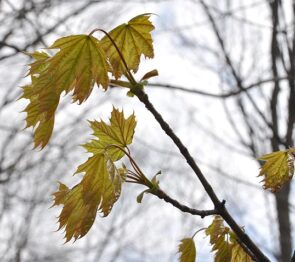
Sugar maple leaves unfurling. (Photos by Audrey Hackett)
This recognition of our essential oneness with the planet was perhaps most globally felt when our 1968 astronauts sent back a picture of Earth as a shining blue marble suspended in space. Later, Lynn Margulis and James Lovelock cemented this idea with their Gaia hypothesis, which posited the earth as a synergistic, balance-seeking system deeply responsive to the biological and energetic interplay of its inhabitants.
“The Limits to Growth,” based on the groundbreaking computer system Earth 3, showed how unfettered growth in population, food production, industrialization, pollution and consumption of nonrenewable natural resources could lead to overshoot and collapse.
Now, 50 years since that first Earth Day and just a few decades short of when Earth 3 predicted cascading systems collapses, we are seeing the limits of mechanistic thinking. From rising seas and flooded fields to wildfires in California, Australia, the Amazon and the Arctic, Earth and its systems are in a paroxysm of change. One million species are in waves of extinction, coral reefs are dying, our oceans are filled with plastic, and plagues of biblical proportions, including locusts in Africa and the coronavirus everywhere, are reminding us of our vulnerability.
Yet we have a path forward.
It has been blazed by indigenous peoples, and those in the last several decades who have been exploring the ways of working in cooperation with nature. From an explosion of research and implementation of renewable energy and battery technologies, to greenscaping and green roofs, to natural building and water systems, new ideas of how to live lightly on the planet have been piloted globally. Simplicity movements and community explorations of an “economics of happiness” are merging with structures like public banks, workers cooperatives, and alternative currencies. In manufacturing, closed loop systems and designing with natural principles suggest ways that we can continue to construct the new while enhancing rather than destroying ecosystems.
Perhaps nowhere have our learnings been so great than in our understanding of the substance for which our dear green planet is named. The surprising life under the soil that’s been detailed in an endless stream of books and movies, including the recent “Fantastic Fungi,” gives us an almost magical sense of the possibilities of partnering with the Earth in the repair of all of us. “The Secret Life of Trees” and “The Secret Life of Plants” expand this notion, describing a quantum and energetic world where communication of all kinds — through light, scents, sounds and electrical impulses — connects us all.
It was the promise of soil that led us to purchase Agraria three short years ago with the help of community members, and to begin its development as a Center for Regenerative Practice. Since then we have been on an exponential learning curve. Most importantly, we have been visiting and learning from partners across the planet who have been regenerating and rewilding landscapes while also repairing regional food systems and local communities.
Our learnings — together with the long-time interests of Community Solutions in local economics, appropriate technologies, regionalized energy systems and Quaker simplicity — suggest tantalizing possibilities for a post-coronavirus future.
Is the virus a black swan, or a message sent back from our future giving us an opportunity to choose again? Our suddenly blue skies, clear waters, wandering wildlife and the hum of the earth more clearly heard by seismologists suggest that we might yet pull back from the brink.
Here in Yellow Springs, individuals and groups have the opportunity to explore what comes next. Can we re-localize our food system, plant flowers to attract pollinators, vote for a Green New Deal, and join in the call for a planetary ceasefire? Can we create our own version of the Civilian Conservation Corps and teach our young people how to plant trees and replace lawns with food forests? Can we collectively vision what Charles Eisenstein called “the more beautiful world our hearts know is possible?”
If not here, where? And if not now, when?
* The writer is the executive director of the Arthur Morgan Institute for Community Solutions.
The Yellow Springs News encourages respectful discussion of this article.
You must login to post a comment.
Don't have a login? Register for a free YSNews.com account.















No comments yet for this article.